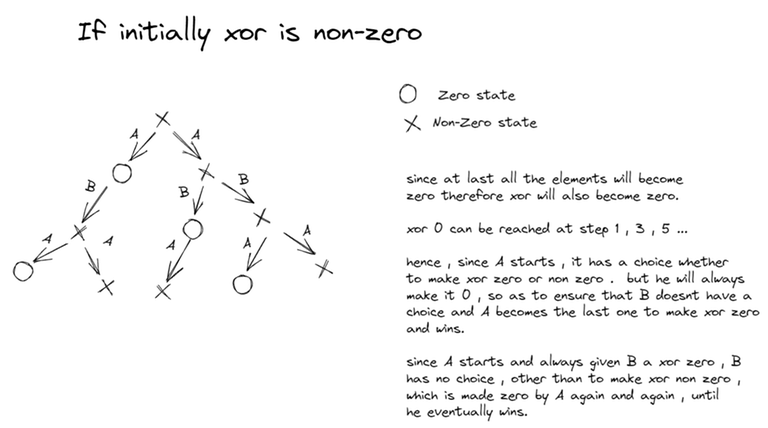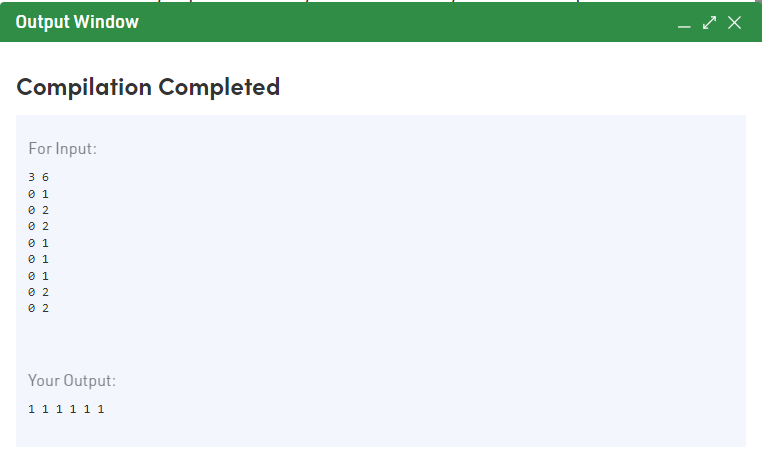It has become a trend for all contests , that A , B , Cs will almost always be constructive , and even after solving a lot of these questions , I mostly seem to get stuck or sometimes take a lot more time than usual to solve these questions.. I just feel like , i'm stuck and can't improve any further, can anyone help?
| # | User | Rating |
|---|---|---|
| 1 | tourist | 3856 |
| 2 | jiangly | 3747 |
| 3 | orzdevinwang | 3706 |
| 4 | jqdai0815 | 3682 |
| 5 | ksun48 | 3591 |
| 6 | gamegame | 3477 |
| 7 | Benq | 3468 |
| 8 | Radewoosh | 3462 |
| 9 | ecnerwala | 3451 |
| 10 | heuristica | 3431 |
| # | User | Contrib. |
|---|---|---|
| 1 | cry | 167 |
| 2 | -is-this-fft- | 162 |
| 3 | Dominater069 | 160 |
| 4 | Um_nik | 158 |
| 5 | atcoder_official | 156 |
| 6 | Qingyu | 153 |
| 7 | djm03178 | 152 |
| 7 | adamant | 152 |
| 9 | luogu_official | 150 |
| 10 | awoo | 147 |
I recently started learning python , so I was looking for some C++ STL equivalents in Python. is there any way i can achieve a similar functionality of —
Set and Maps in python with —
insert (log n) delete (log n) find (log n)as fas a I Understand Python Standard Sets are not sorted and are implemented using Hash-Tables (similar to unordered-Sets in C++) has —
insert (O(1) average case , Worst case O(n) [when large no of values have same hash value]) delete (O(1) average case , Worst case O(n) [when large no of values have same hash value]) find (O(1) average case , Worst case O(n) [when large no of values have same hash value])I know there is a third party package called sortedcontainers which has some C++ equivalents —
std::set sortedcontainers.SortedSet std::multiset sortedcontainers.SortedList std::map sortedcontainers.SortedDictbut I want to get these funcionalities without installing any third party packages (because those would be local to my environment), and I want to submit to codeforces.
can anybody help?
What is Nim Game and how it is played?
It is a game in which two players play optimally turn by turn .
-
In each turn a player can choose only one pile and remove any number of stones (at least one) from that pile.
-
The person who is unable to make a move looses , hence the player who makes the last move wins.
-
determine which player wins the game.
How to decide who will win?
To decide who will win the initial configuration of the piles matter.
-
If the xor of all elements of the array is non-zero , then person starting the game will win.
-
If the xor of all elements of the array is zero , then other person will win.
-
Why it works ?
-
if the xor if all elements is zero then if we make any moves , the xor of all elements will definitely become non zero .
since if the xor of all elements is zero therefore each power of 2 has even no of bits . now if we reduce any no of the array , then atleast one set bit will be turned off (since we are reducing the number). if a set bit turns off , then that power of 2 now has odd no of bits set, hence xor off all elements becomes non zero.
If the xor of all elements is non zero , then we can either make the xor non-zero again , or make the xor zero.
-
There definitely exists atleast one way to make xor zero again.
-
Since the xor is non zero , therefore there are some powers of two that have odd no of bits set.
-
To reduce a number if we turn off a bit , then even if we set all the bits on it's right , then too the number is still smaller than the original number (hence it is still a reduced no).
-
So we will just find the largest power of 2 that has odd no of bits set
-
Then take any number that has that bit set , and turn that bit off in that number
-
Now this power of 2 has even no of bits set.
-
For the rest power of 2s that have odd no of bits set , if this no has that bit set , just turn it off , else turn it on since all these bits lie on the right of the initial bit , therefore the number is still reduced.
How to reach the Conclusion -


Conclusion -
Hence if xor is zero B Wins , else A wins
Is there any website/tool that displays heatmaps and other related statistics of a profile of Codechef?
Can anyone tell me how the output of Test case 3 of Problem is —
9 9 9 15 15 6 -1 -1 6 -1 -1 -1 -1 6 15
and not —
9 9 9 -1 8 6 -1 -1 6 -1 -1 -1 8 6 8
the as far as i understand — i have to perform N moves , where -
- Draw the topmost card from the deck. Let X be the integer written on it.
- Then i will find a stack of upfacing cards with the smallest integer greater than or equal to X written on and and i will put this X card into that stack .
- if there is not such stack then i will put this card into a new stack.
- if any stack has k cards i will eat that stack.
for input —
15 3 3 14 15 9 2 6 5 13 1 7 10 11 8 12 4
According to me the steps should look like —
- 3 (new stack)
- 3 14 (two new stacks)
- 3 14 15 (three new stacks)
- 3 ( 14 9 ) 15 (9 goes to stack 2)
- (2 3) ( 14 9 ) 15 (2 goes to stack 1)
- (2 3) ( 6 14 9 ) 15 (6 goes to stack 2)
- now stack 2 to is eaten because it has size = 3 (therefore 6 , 14 , 9 is eaten at step 6)
- (2 3) (5 15) (5 goes to stack 3)
- (2 3) (13 5 15) (13 goes to stack 3)
- now stack 3 to is eaten because it has size = 3 (therefore 13 , 5 , 15 is eaten at step 8)
- .
- .
- . -and so on..
can anyone tell me where i am getting it wrong? thanks in advance
Even after a lot of Practice why do I perform well in virtual contest but fail to perform well in real contests? . How can I overcome the fear of rating fall , and learn to perform well under pressure ? Does anyone have any suggestions that would help?
I had been giving some virtual contests , and i see i mostly perform well in them , and get a good rank , but in actual contest i almost always end up performing bad , even though i know i could have easily solved those questions if i was not under pressure .
Any suggestions for overcomming this would be really helpful :>
I get this when i submit code —

but when i run my exact same testcase in test against custom input window i get —

which is the correct output.
here is my submission — Submission
what am i doing wrong?
can anyone tell me how to make a custom hash for an —
unordered_set< pair < unordered_set<vector< int > , hashFunction > , vector< int > > >
where hashFunction is a custom hashFunction for unordered_set<vector> .
here it is —
struct hashFunction //hash function for unordered set
{
size_t operator()(const vector<int> &myVector) const
{
std::hash<int> hasher;
size_t answer = 0;
for (int i : myVector)
{
answer ^= hasher(i) + 0x9e3779b9 +
(answer << 6) + (answer >> 2);
}
return answer;
}
};Given a weighted undirected graph , a source vertex(s) and x distinct vertices as Delivery Location (d1 , d2 , d3 .. dx) assuming that each rider travels at 1m/s what is the min time required to complete all the deliveries if you have M drivers originating from the source simultainously , and also the path followed by them.
( it is guarented that reaching all delivery locations from the source vertex is possible )
input format -
n m s M //n vertices , m edges , s is the source vertex , M no of drivers
v11 v12 w1 //vertices connected with weight w
v21 v22 w2
..
vm1 vm2 wm
x // no of delivery locations 1<= x < n
d1 , d2 , d3 , d4 .... dx //delivery vertices (d[i] != s for all 1 <= i <= x)
output format - (M+1 lines first line should contain the min time required and all others M lines should include paths followed by drivers from 1 to M)
t //min time to complete all deliveries
1->3->5 // path followed by first delivery guy
1->2->1->5 // path followed by second delivery guy
1-> path followed by third delivery guy (it may be possible that this delivery person didn't moved so his path finished at source only)
(all paths should start from source only)
given a NxM integer matrix and i1,j1,i2,j2
such that i1 < i2 and j1 < j2
tell in O(1) that whether all elements in the rectangular submatrix formed by (i1 , j1) , (i1 , j2) , (i2 , j1) , (i2 , j2)
contains all same elements or not .
example —
input —
6
0 1 1 1 0 1
4 4 4 4 1 0
1 2 2 4 2 4
1 1 2 2 2 4
4 4 4 4 2 4
4 4 4 4 4 0
4 0 5 3 // zero based indexing , i1 , j1 , i2 , j2
output — yes
Given a Binary String and a number x , tell whether there exists a continuous substring with ( no of zeros — no of ones ) = x output its index l to r (0 based indexing) eg —
string = 1 1 0 0 1 0 0 1 0 0 1 0 1 1
x = 3
output — (you can output any possible l to r)
YES , from index 2 to index 6
ORYES , from index 2 to index 8
Can anyone help me figure out what is wrong in my Code , the poblem is pretty straight forward and i Implemented it using PBDS , but i am getting WA in 5 added Testcases . Here is my submission Link — Submission
i recently encountered a problem — 1208B - Uniqueness
I have use a simple Binary search approach for that problem
I have 2 submissions , both are using Binary search and both have same worst case time complexity of O(N^2 log^2(N)) but one gives TLE and the other gets AC
AC submission — 146479295
TLE Submission — 146333083
can anyone tell me why this is happening?
My approach was to map characters 'a' with the first character in the string then ,'b' with the second character in the string .. and so on , then while taking input of the N strings I converted those string(X) to a mapped string(Y) (each character conveted to its mapped value) and stored that mapped string(Y) in a multiset key with vaue as the original string(X), i did this as multiset will sort the keys lexographically and then i just printed the values of the map,
the first two given testcase gives right ans , but i dont understand why all other testcases give WA.
ps. i also solved it with custom comparator function which got AC(As expected) , but i don't understand why this approach gives me WA
| Name |
|---|










